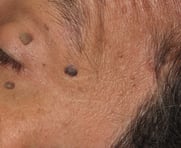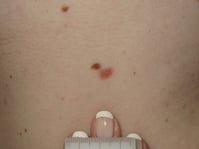Basal cell carcinoma: An overview
Basal cell carcinoma (BCC) is the most common form of skin cancer. It arises from abnormal, uncontrolled growth of the skin’s basal cells and usually develops slowly. Most BCCs are curable and cause minimal damage when caught early, although they can cause significant scarring and disfigurement if left untreated. Understanding the causes, risk factors and warning signs for BCC can help you spot these skin cancers early when they are easiest to treat.
What causes BCC?
Basal cells are one of the three main types of cells in the top layer of the skin. BCCs occur when these cells are exposed to the sun’s ultraviolet (UV) radiation, which causes DNA damage and uncontrolled cell growth. Cumulative UV exposure over time is the leading cause of BCC.
BCC accounts for about 70 per cent of the 980,000 non-melanoma skin cancers that are treated every year in Australia.
What does BCC look like?
BCCs can sometimes look like anything! They can resemble open sores, red patches, pink growths, shiny bumps, scars, or growths with a central indentation. Some BCCs may crust, itch or bleed. Some BCCs are brown in colour. They most often arise in sun-exposed areas on the skin.
The below images are examples of real basal cell carcinomas.


-jpeg-1.jpeg?width=199&name=BCC%20nodular%20(1)-jpeg-1.jpeg)
%20(1)-jpg-1.jpeg?width=199&name=BCC%20(1)%20(1)-jpg-1.jpeg)
Is BCC dangerous?
BCCs rarely spread into other areas of the body; however, they can be severely disfiguring if left untreated, even growing into the surrounding skin, tissue, and bone. The longer a BCC is left untreated, the more likely it is to recur in the future. On the rare occasion that BCC does spread into other organs, it can be life-threatening.
Who is at risk of BCC?
BCC is the most common form of skin cancer and the most frequently occurring form of all cancers. Any of the below factors can put you at higher risk of developing the disease:
- A family or personal history of skin cancer
- UV exposure from the sun or tanning beds
- Aged over 50
- Fair skin or light-coloured hair or eyes
- Male
- A compromised immune system
- Five or more sunburns
- Working outdoors
- Spending a lot of time in the sun
To find out your skin cancer risk, take our quick quiz.
How can BCC be prevented?
Skin cancer is a largely preventable disease. You can protect yourself against developing BCC by adopting sun safe habits like wearing sunscreen, a hat, sunglasses, and long sleeves; seeking shade whenever you are outdoors; and avoiding going outside in UV peak times (usually between 10.00am – 3.00pm).
It’s also important to keep an eye on your own skin for anything new, changing or unusual, and get a professional skin cancer check at least once a year (or more often if you are at high risk of skin cancer).
Learn more about preventing skin cancer here.
How is BCC treated?
Most BCCs can be treated and cured if found early. The longer a BCC grows, the more invasive and difficult the treatment becomes. The treatment will depend on the size of the BCC, where it is located on your body, and certain other factors your doctor will discuss with you.
Treatment options for BCC can include:
- Curettage and cautery, where the cancer is scraped off and heat is applied to the skin's surface;
- Mohs surgery, in which a small amount of skin tissue is shaved off repeatedly until the margins come back clear of cancerous cells;
- Excision, where the BCC is surgically cut out;
- Radiation therapy, in which the cancer is destroyed with beams of intense energy;
- Photodynamic therapy, in which a special light and a topical cream are used in combination to kill cancer cells; and/or
- Topical creams, which are applied to the skin in cases of very superficial BCCs or in areas where it is difficult to perform surgery.
Learn more about skin cancer treatments here.
